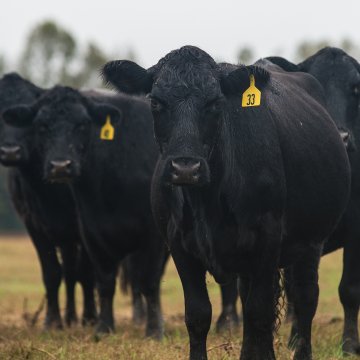A mental health counselor says dealing with stress on the farm has changed in the past few years....
Hard-Hit Ranchers Buy Hay to Hold Herds in Drought

As drought worsens, emergency measures are taking place, and cattle producers have begun to ship in hay to survive. Big rigs stacked high with hay rolls are headed to the High Plains and other Western states, as ranchers in drought-stricken areas try to hold on to their herds a little longer.
One of the hardest-hit states right now is South Dakota, where Governor Kristi Noem just signed an Executive Order declaring a state of emergency for drought and allowing ditch mowing in some parts of the state to help provide hay to ranchers.
Governor Noem, who grew up on a family ranch, noted in a news release from her office that the increased flexibility will allow producers to immediately gain access to hay for their livestock. She added that, with a mild winter and early spring, most of the pheasant hatch has already occurred, and they do not expect the mowing to affect pheasant numbers.
This follows as thousands of acres of Conservation Reserve Program (CRP) continue to open, allowing haying and grazing to help offset forage losses in drought areas. USDA authorizes emergency haying and grazing on CRP acreage to either improve quality and performance on the land or to provide emergency relief to livestock producers. Each week, USDA updates counties eligible for emergency haying and/or grazing. More than 1,000 counties have been granted the go-ahead to open CRP ground. Eight states are currently 100% eligible to do so, including: Arizona, California, Nevada, New Mexico, North Dakota, Oregon, Utah and Wyoming. Colorado has 98% of its counties open; South Dakota has 92% open. It is expected more counties will be added as drought conditions continue to spread and worsen.
Hector Menendez is part of South Dakota State University's (SDSU) drought task force. The Research and Extension Livestock Grazing specialist provided an on-the-ground report regarding hay and grazing conditions in his area. "Earlier in the season, we had a lot of grasses set back about three weeks," he said. "Colder temperatures held onto cooler season grasses and slowed them down. Then, we got the heat waves and higher winds, and by early spring, we were already seeing drought conditions, with the northwest corner of the state hit the hardest."
Menendez reports that where appropriate they are actively encouraging destocking of pastures in anticipation of low hay supplies. While a 5-inch rain gave that northwestern corner of the state some bump in hay production earlier, there has been no rain since, and it is dry again. He calls the situation "dire" regarding hay production this year for most of the state. "The producers I talked to told me they are looking at hay production that will be about one-fourth of normal," said Menendez. "That was in the southwestern part of the state. Based on what I'm hearing, this is a common situation. Everyone is looking for hay."
Menendez added he is hearing at the private level that producers are already buying and paying the transportation costs to get hay delivered from other states. The release of highway grasses for haying and the opening of CRP ground for haying and grazing will also help. In addition, he noted there are Farm Service Agency (FSA) forage-related programs for producers who document their losses, which will allow them to seek assistance. Livestock operations affected by severe or exceptional drought can apply for assistance through the Livestock Forage Disaster Program, which provides payments to help producers and contract growers who have suffered grazing losses due to qualifying drought.
Asked about prices South Dakota producers are currently paying for rolls of utility hay, Menendez said he isn't confident in sharing those numbers yet because they are so fluid. The most recent USDA-AMS reports on hay prices in the state of South Dakota showed utility hay at $100 per ton on the low end. That would be local and not include transportation costs.
Menendez said they are telling producers if they don't have pasture capacity, they need to look at lowering stocking rates sooner rather than later. "When we look at the supply/demand rule of economics, what typically happens is that everyone starts to realize at about the same time they need to act. They start destocking at the same time," he said, adding that producers who can make the hard decisions regarding destocking sooner rather than later may save themselves from selling at the low end of the market.
According to Menendez, SDSU experts are actively working to provide tools to producers to get them through the drought, including a grazing exchange website, alternatives to lease land, where to buy hay in state, nitrate testing and more. And, while the drought and hay are the primary focus right now, he cautions against overlooking livestock performance and health as the industry works through this situation. "We absolutely recommend nitrate testing on hay this year," he said. "Heat and the growing patterns this year can cause nitrates to accumulate, and that can kill cattle. In addition, don't overlook the importance of testing your water and be alert for blue-green algae, which can occur in these conditions as minerals and elements accumulate."
EDITOR’S TAKE:
What a devastating position for cattle producers. They face the dilemma of reducing their herd that they may have spent years building or purchasing hay at escalating prices in a last-ditch effort to survive. The drought is intense and spreading according to the National Oceanic & Atmospheric Administration (NOAA). Other options may be available in limited form. For instance, alternative feedstocks might help fill the gap. What they really need, however, is rain! The latest forecast for parts of the affected area is a little more promising for the week ahead. We certainly hope that some relief is on the way before cattle markets become completely skewed by ranchers deciding to downsize or liquidate completely.








